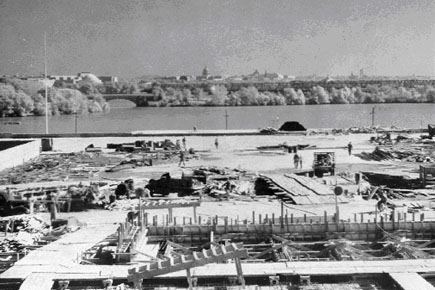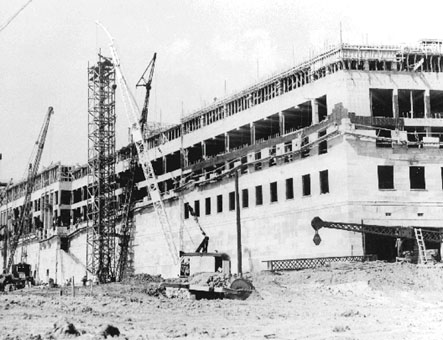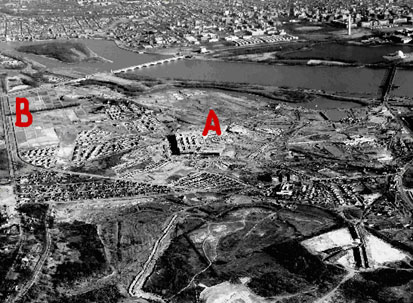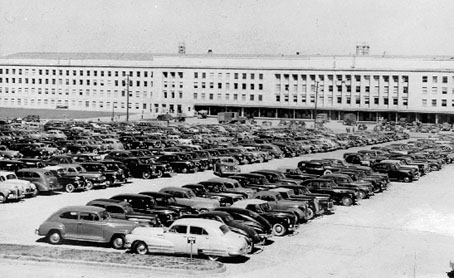Under the Pressure of War, the Corps Built the Pentagon in 16 Months
By the summer of 1941, the War Department work force in the Washington, D.C. area numbered more than 24,000 civilian and military personnel housed in 17 buildings and was expected to reach 30,000 by the beginning of 1942. Providing office space for the workers was part of the military construction mission of the Quartermaster Corps’ Construction Division, already struggling to cope with the vast mobilization construction underway before the United States entered World War II.
 |
| BG Brehon B. Somervell |
 |
| BG Hugh J. Casey |
The federal government considered constructing temporary buildings, but Brigadier General Brehon B. Somervell, an aggressive Engineer officer who headed the construction division, had another idea. On Thursday, 17 July 1941, he summoned two of his subordinates, Lieutenant Colonel Hugh J. Casey, also an Engineer officer, and George E. Bergstrom, a prominent civilian architect, and told them that by Monday morning he wanted basic plans and an architectural perspective for an air-conditioned office building to house 40,000 workers in four million square feet of space, not more than four stories high, with no elevators. Indeed, Lieutenant Colonel Casey and his staff completed the basic layout of a five-sided building by that following Monday, after what he later described was “a very busy weekend.”
The War Department staff approved the building’s basic concept that Monday and the Secretary of War approved it on Tuesday, informing President Franklin D. Roosevelt of his plans. Also on Tuesday Somervell took the plan to Congress. Sensitive to the severity of the space problem, Congress and the president moved quickly to approve a supplemental defense appropriation bill, including $35 million for the construction of the proposed War Department headquarters.
The plans underwent many changes in the next few months, including changes in location. With Somervell’s approval, Casey and Bergstrom sited the building between Arlington National Cemetery and Memorial Bridge. Some federal agencies and local citizens did not want the proposed building to obstruct the vista between the Lincoln Memorial and Arlington Cemetery. Appeasing opponents, in August President Roosevelt moved the site to its current location.
Plans for the building proceeded swiftly. Bergstrom with architect David J. Witmer developed plans for a unique reinforced concrete building that would consist of five concentric pentagons separated by light wells and connected by radiating spoke-like corridors. It would have five stories and include a six-acre interior court, numerous ramps and escalators, a large shopping concourse on the first floor, taxi stands and bus lanes, and parking for 8,000 cars.
Construction commenced on 11 September 1941, and continued rapidly during the winter of 1941-42. Architects for the project had little or no lead time; sometimes construction actually outpaced planning. On 1 December 1941, when the president signed legislation transferring the military construction mission from the Quartermaster Corps to the Army Corps of Engineers, 4,000 men were laboring on the building in three shifts. One section was completed by the end of April 1942 and the first tenants moved in. The basic shell and roof were finished in one year, and the building was completed by 15 January 1943.
 |
| Early ground floor Pentagon construction |
 |
| Pentagon roof construction |
 |
Northwest exposure of the Pentagon's construction underway, 1 July 1942
(part of south parking area in foreground) |
 |
| Construction of the fifth floor begins as well as the bus and taxi entrances to the Pentagon |
The Pentagon’s designers minimized or avoided using critical war materials whenever possible. They substituted concrete ramps for passenger elevators and used concrete drainpipes rather than metal. They eliminated bronze doors, copper ornaments, and metal toilet partitions, and avoided any unnecessary ornamentation.
The Pentagon was the largest office building in the country at that time, covering 29 acres and housing 17.5 miles of corridors. Design and construction of such a building would normally have taken four years, but the Corps took only 16 months. At its peak the Pentagon housed nearly 33,000 workers.
The architects and Engineer officers who designed and constructed the Pentagon produced one of the most innovative and unique structures of the war era. With this massive yet efficient structure, the Corps not only resolved the problem of housing thousands of War Department employees during the war years, they also provided for future War Department needs.
 |
Aerial view depicts the first two Pentagon "spokes" under construction (A).
(B) indicates a proposed location for the Pentagon |
 |
| The Pentagon's facade nearing completion as work on one of the drives is underway |
 |
Part of the south parking area of the completed Pentagon,
south loading platform in the background |
* * *
September 2001